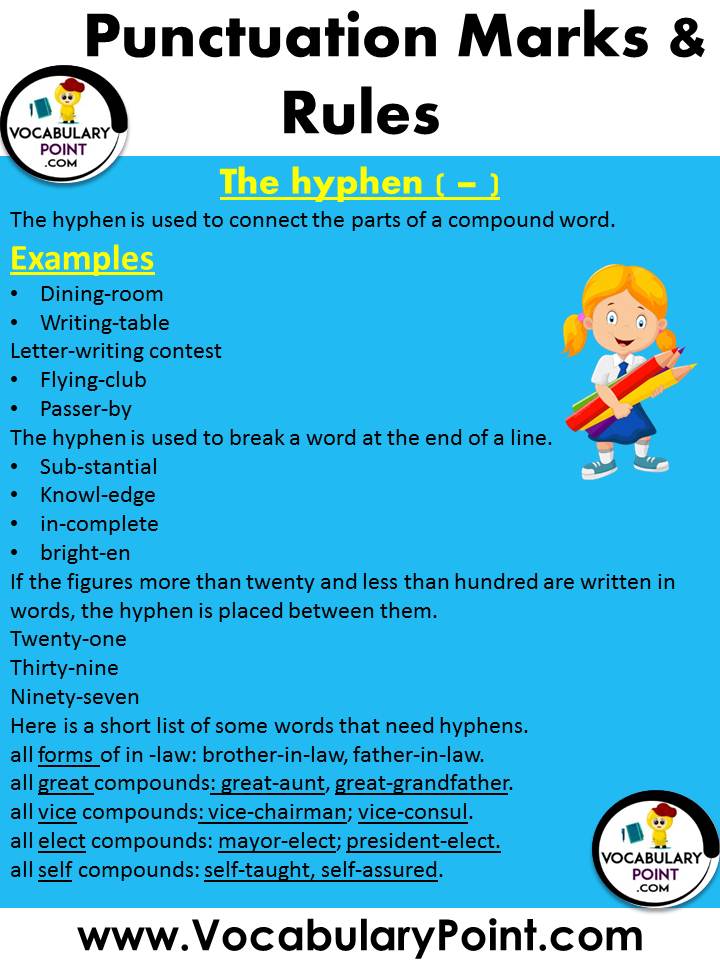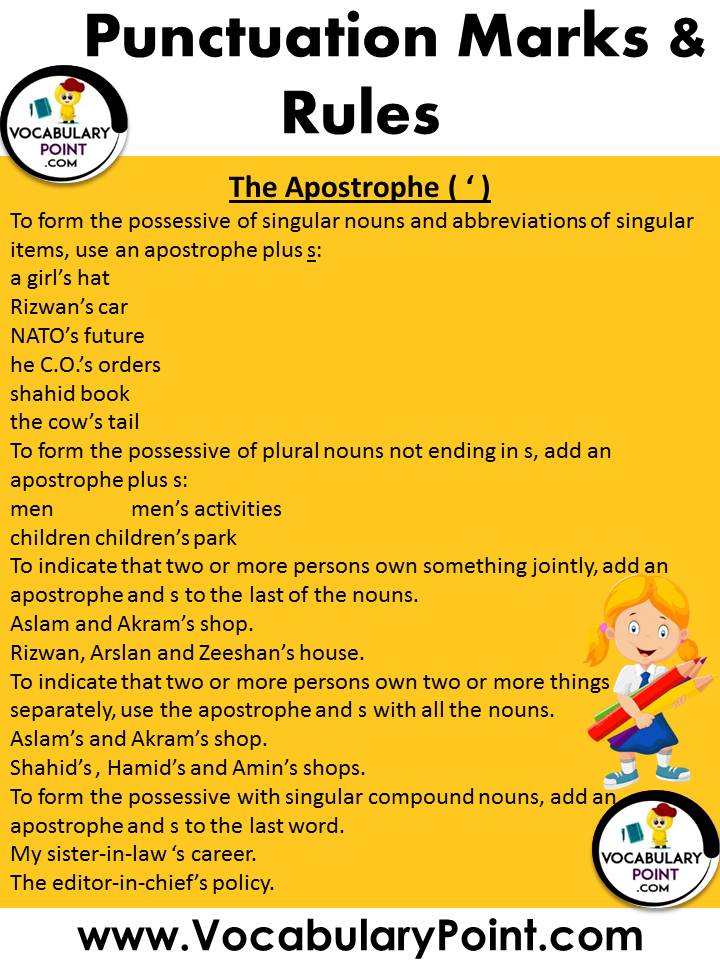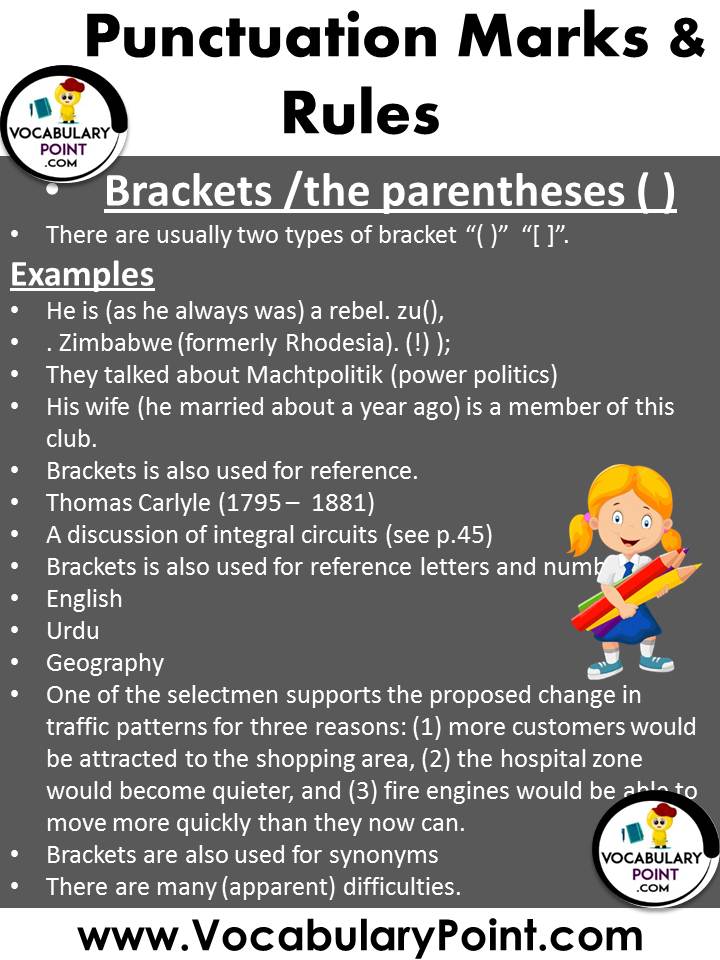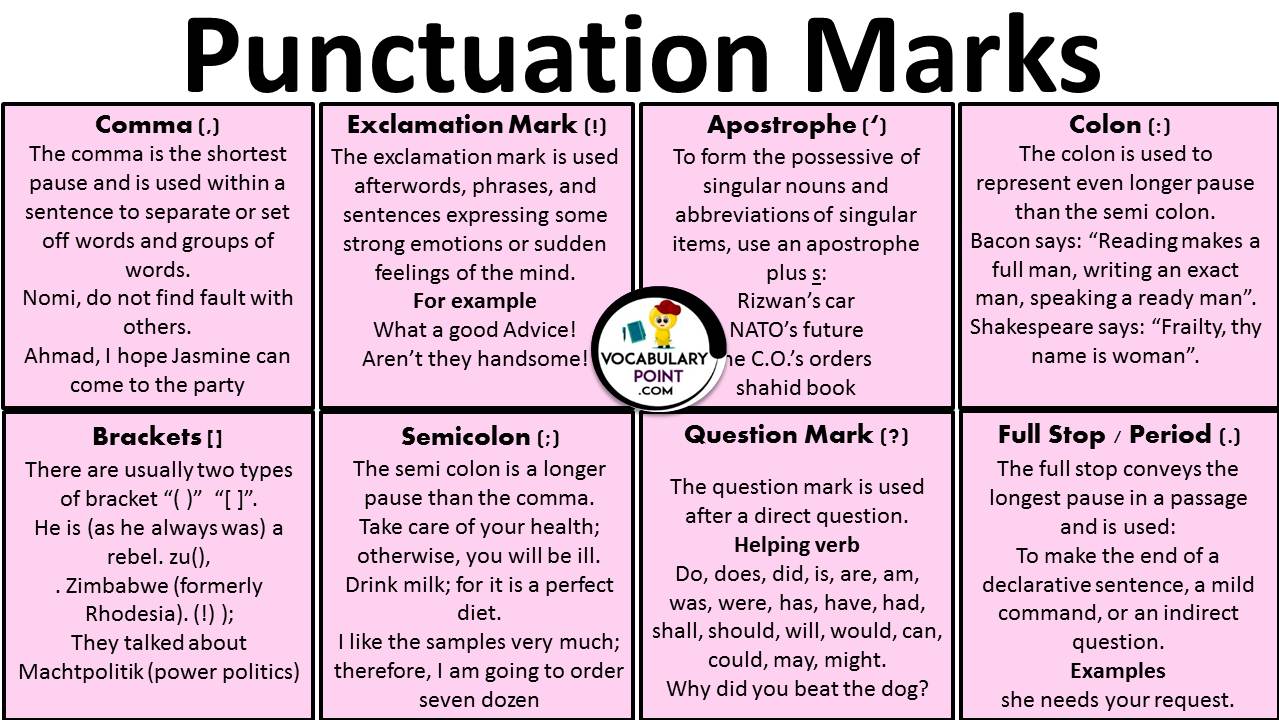Punctuation Marks Rules and examples pdf are very important for English learning. Punctuation marks are crucial in shaping the structure and meaning of written language. They guide readers through sentences, clarifying intent and tone. Understanding these symbols, from periods to exclamation points, is key to effective communication. Here’s a brief overview of their rules and examples, helping to demystify these essential elements of writing.
What are punctuation and Punctuation Marks?
Punctuation marks are symbols used in written language to organize sentences and clarify meaning. They help indicate pauses, intonation, and sentence structure, facilitating clear and effective communication. These marks include common symbols like periods, commas, question marks, exclamation points, and others, each serving distinct roles in grammar and writing.
Here are 14 Common Punctuation Marks :
- Period (.)
- Comma (,)
- Question mark (?)
- Exclamation point (!)
- Colon (:)
- Semicolon (;)
- Quotation marks (” “)
- Apostrophe (‘)
- Hyphen (–)
- Dash (—)
- Parenthesis ( )
- Brackets [ ]
- Ellipsis (…)
- Slash (/)
Punctuation Marks Rules and Examples
Period (.)
A period (.) is a punctuation mark that is used to indicate the end of a sentence. It is also called a full stop or point. When used, the period is placed at the end of a declarative or an imperative sentence to indicate that it is complete and is not part of a larger thought. The period is also used in abbreviations and initials, as well as in numbers used as decimals. The proper use of the period is important to convey meaning and clarity in writing.
Rules for Using a Period (.)
- End declarative sentences.
- Conclude imperatives.
- Follow abbreviations.
- Separate reference citation elements.
- End polite requests disguised as questions.
- Use in decimal numbers.
- Indicate ellipsis for omitted text.
- Separate hours and minutes in times.
- Conclude sentences within parentheses or brackets.
- Terminate quoted sentences within a sentence.
Examples of Using a Period (.)
- “She loves reading.”
- “Close the door.”
- “U.S.A. stands for United States of America.”
- “See the article on page 5.”
- “Would you kindly shut the window.”
- “The total is $10.50.”
- “She said she would come…”
- “The event starts at 3:00 p.m.”
- “He was late (as usual).”
- “She whispered, ‘I love you.’ and walked away.”
Comma (,)
The comma (,) is a punctuation mark used to indicate a brief pause in a sentence. It separates elements within a sentence to clarify meaning and ensure correct understanding.
Rules for Using a Comma
- Separate elements in a series.
- Set off introductory elements.
- Join independent clauses with a conjunction.
- Separate nonessential information.
- Separate adjectives of equal rank.
- Set off direct address.
- Separate dates, addresses, and titles.
- Indicate direct speech.
- Separate contrasting parts.
- Avoid confusion.
Examples of Using a Comma
- “I bought apples, oranges, and bananas.”
- “In the morning, we went jogging.”
- “She is smart, but she lacks experience.”
- “My brother, a doctor, is visiting.”
- “It was a long, tiring journey.”
- “John, can you pass the salt?”
- “She was born on July 4, 1980, in Paris.”
- “He said, ‘I will be late.'”
- “She’s poor but, unlike her brother, very ambitious.”
- “Let’s eat, Grandma!” (to avoid confusion with “Let’s eat Grandma!”)
Question mark (?)
The question mark (?) is a punctuation mark that is used at the end of a sentence to indicate that it is a question. It is used in written language to show that the writer is asking a direct question, seeking information, or expressing uncertainty.
Rules of Question mark (?)
- End Direct Questions: Use at the end of a sentence that is a direct question.
- Example: “What time is it?”
- In Place of Periods for Queries: Replace the period with a question mark in any sentence structured as a query.
- Example: “Are you coming with us?”
- For Rhetorical Questions: Apply to rhetorical questions where no answer is expected but a query is posed.
- Example: “Isn’t it a beautiful day?”
- Question Within a Sentence: Use within a sentence for a parenthetical question.
- Example: “He asked me, ‘Are you okay?’ before leaving.”
- Multiple Questions in a Row: Use for each question in a series of short, direct questions.
- Example: “Is this your book? Your bag? Your coat?”
- Indirect Questions Do Not Require: Do not use after indirect questions.
- Example: “I wonder what time it is.”
- Titles of Works with Questions: Use in titles of books, articles, or songs that are phrased as questions.
- Example: “Who Moved My Cheese?”
- At the End of Tag Questions: Use after tag questions added to the end of statements.
- Example: “You’re coming, aren’t you?”
- For Uncertain Statements: Sometimes used in brackets to show the uncertainty of a statement.
- Example: “She will arrive in April [?]”
- Not Used for Indirect or Polite Requests: Avoid using with indirect or polite requests that are structured as questions.
- Example: “I wonder if you could help me.”
Examples of Question mark (?)
- “What is your name?”
- “Did you finish your homework?”
- “How do you make a cake?”
- “Why did you choose that outfit?”
- “Where are you going for vacation?”
- “Can you believe she did that?”
- “Are you coming to the party?”
- “What time is the meeting?”
- “Who won the game?”
- “Do you like ice cream?”
Exclamation point (!)
An exclamation point (!) is a punctuation mark that is used to indicate strong feelings or emphasis in a sentence. It is typically used to show excitement, surprise, anger, or other intense emotions.
Rules of Exclamation point (!):
- Use an exclamation point after an exclamation or interjection that expresses strong emotions.
- Example: Wow!, Congratulations!, Yay!
- Use an exclamation point to show surprise, shock, or astonishment.
- Example: I can’t believe it!, What a surprise!
- Use an exclamation point to indicate emphasis or intensity.
- Example: The view is stunning!, This is absolutely amazing!
- Avoid overusing exclamation points, as this can detract from their impact.
Examples of Exclamation point (!):
- “That was incredible!”
- “Help!”
- “I won the lottery!”
- “Congratulations on your promotion!”
- “What a beautiful day!”
- “Stop!”
- “This is amazing!”
- “I can’t believe it worked!”
- “You’re amazing!”
- “Hurray!”
Colon (:)
A colon (:) is a punctuation mark that is used to introduce a list or an explanation, or to separate two independent clauses when the second clause explains or illustrates the first clause.
Rules of Colon (:)
- Introduction to a List: Use a colon to introduce a list, especially after a complete sentence.
- Separating Independent Clauses: Use a colon between two independent clauses when the second explains or elaborates on the first.
- Before a Quotation: A colon can precede a quotation, particularly a formal or lengthy one.
- Time and Ratios: Use colons to separate hours from minutes and in ratios.
- In References and Citations: Employ a colon in bibliographic references, between the title and subtitle of a book, and in scriptural references.
- Business Letters: Place a colon after the salutation in formal business letters.
- Emphasis: Use a colon to emphasize a phrase or single word at the end of a sentence.
- In Titles: Colons are used in academic papers and articles to separate the main title from a subtitle.
- Before a Long, Formal Statement or List in a Sentence: Especially in formal writing, a colon can introduce a statement or list.
20 Examples of Colon (:)
- My favorite colors are: red, blue, and green.
- Please bring the following items: a pen, paper, and a calculator.
- There was only one thing left to do: run.
- She had one thing on her mind: revenge.
- His explanation was simple: he didn’t know.
- He quoted his favorite line from the movie: “You can’t handle the truth!”
- The recipe called for three ingredients: sugar, flour, and eggs.
- The teacher gave us one assignment: write an essay.
- The presentation covered three main points: history, culture, and traditions.
- The movie was based on a true story: the life of a famous athlete.
- The sign said: “No trespassing.”
- The email said: “I will see you at 6 pm.”
- She wrote a letter to her boss: “Dear Mr. Smith:”
- The article was titled: “10 Tips for a Successful Job Interview.”
- His favorite song was: “Stairway to Heaven.”
- He had a simple message for his team: “Never give up.”
Must Learn: Adjectives for Flower
Semicolon (;)
A semicolon (;) is a punctuation mark that is used to separate two independent clauses that are closely related, to separate items in a list that contain commas, or to clarify a series that contains commas.
Rules of Semicolon (;):
- Connect closely related clauses.
- Link with conjunctive adverbs.
- Separate complex list items.
- Clarify heavily punctuated sentences.
- Resolve comma splice errors.
- Enhance readability in lists.
- Balance lengthy, intricate clauses.
- Introduce quotes or examples.
- Contrast sharply connected ideas.
- Replace periods for nuance.
Examples of Semicolon (;):
- I love books; they inspire me.
- She runs daily; he lifts weights.
- Plants need water; flowers need sunlight.
- He’s late; she’s already left.
- Rainy days depress me; sun uplifts.
- Studied hard; still didn’t pass.
- Cats are independent; dogs are loyal.
- Tea is soothing; coffee is energizing.
- Wrote a novel; published it myself.
- Traveled abroad; gained new perspectives.
Quotation marks (” “)
Quotation marks (” “) are punctuation marks used to indicate a direct quote or a title of a short work.
Rules of Quotation marks (” “):
- Direct Speech: Enclose the exact words spoken by someone.
- Titles of Works: Use for titles of short works, like articles or poems.
- Irony or Sarcasm: Indicate a word is used in an unusual or ironic manner.
- Unfamiliar or Coined Terms: Enclose words used in a non-standard way or newly coined phrases.
- Reporting Speech: Indicate reported speech, thoughts, or phrases within a narrative.
- Quoting Text: Use to quote from a text or another source.
Examples of Quotation marks (” “):
- Direct Speech: “I can’t believe it’s already Friday,” she exclaimed.
- Titles: I just read “The Great Gatsby.”
- Irony: He is a real “genius” at forgetting things.
- Coined Terms: She described her mood as “hangry.”
- Reporting Speech: My teacher said, “Finish your homework.”
- Quoting Text: The sign read, “No Parking.”
- Sarcasm: Oh, that’s a “great” idea!
- Short Works: My favorite poem is “The Road Not Taken.”
- Highlighting Terms: The word “metamorphosis” has many meanings.
- Dialogue: “Where are you going?” he asked.
- Technical Terms: The doctor mentioned “tachycardia.”
- Book Chapters: I loved the chapter “The Encounter.”
- Slang Words: She used the word “lit” to describe the party.
- Movie Titles: Have you seen “Inception”?
- Emphasize: He said it was “absolutely necessary.”
- Nicknames: Michael “Air” Jordan is a basketball legend.
- Song Titles: My favorite song is “Yesterday” by The Beatles.
- Foreign Words: She spoke the French phrase “c’est la vie.”
- Jargon: In programming, “loop” refers to a sequence of instructions.
- Sarcastic Implication: He’s the “expert” on the topic.
Apostrophe (‘)
An apostrophe (‘) is a punctuation mark used to indicate possession or to indicate the omission of letters in a word.
Examples of Apostrophe (‘)
- Possession: Indicating ownership or possession.
- Singular noun: “The cat’s whiskers are long.” (referring to the whiskers of one cat)
- Plural noun: “The dogs’ leashes were tangled.” (referring to leashes belonging to multiple dogs)
- Contractions: Showing where letters or numbers have been omitted.
- “Don’t” (short for “do not”)
- “I’ll” (short for “I will”)
- “Class of ’22” (short for “Class of 2022”)
- Plural forms of letters, numbers, and symbols: Sometimes used to indicate the plural of letters, numbers, or symbols, especially when clarity is needed.
- “Mind your p’s and q’s.”
- “She got two A’s and three B’s.”
- “There are four #’s in the password.”
- Slang or colloquial speech: Occasionally used to represent dropped letters in colloquial speech or dialects.
- “Walkin’” (instead of “Walking”)
- “Goin’” (instead of “Going”)
Rules of Apostrophe (‘)
The apostrophe (‘) is a versatile punctuation mark used in English for a few specific purposes. Understanding its rules is crucial for correct grammar and punctuation. Here are the primary rules for using apostrophes:
- Showing Possession:
- Singular nouns: Add an apostrophe followed by an ‘s’ to show that something belongs to someone or something. Example: “The dog’s leash” (the leash belonging to the dog).
- Plural nouns ending in ‘s’: Add only an apostrophe after the existing ‘s’. Example: “The dogs’ owner” (the owner of multiple dogs).
- Plural nouns not ending in ‘s’: Add an apostrophe followed by an ‘s’. Example: “The children’s playground” (the playground for the children).
- Indicating Omissions in Contractions:
- Apostrophes replace omitted letters in contractions. Examples: “Don’t” (for “do not”), “I’m” (for “I am”), “He’s” (for “He is” or “He has”).
- Forming Plurals of Letters, Numbers, and Symbols:
- When you need to show the plural of single letters, numbers, or symbols, especially where not using an apostrophe might lead to confusion. Examples: “Dot your i’s and cross your t’s,” “Find all the number 7’s.”
- Special Cases:
- Joint possession: When two or more people own something together, place the apostrophe only after the last name. Example: “Alice and Bob’s car” (a car owned by both Alice and Bob).
- Separate possession: When two or more people own separate items, place an apostrophe with ‘s’ after each name. Example: “Alice’s and Bob’s bikes” (each owns a separate bike).
- Singular nouns ending in ‘s’: Traditionally, add an apostrophe and another ‘s’. Example: “James’s book.” However, just an apostrophe is also acceptable, especially in names: “James’ book.”
Remember, do not use apostrophes:
-
- To form plurals of regular nouns. Incorrect: “Apple’s for sale.”
- With possessive pronouns (his, hers, its, ours, yours, theirs). Incorrect: “The book is her’s.”
Hyphen (-)
A hyphen is a punctuation mark used to connect two or more words or to split a word that cannot fit on a line. Here are some rules and examples of using a hyphen:
Rules of Hyphen (-)
- Connecting words: A hyphen is used to connect two or more words to form a compound word.
- Example: father-in-law, self-esteem, well-known
- Splitting words: A hyphen is used to split a word at the end of a line when the word cannot fit entirely on one line.
- Example: “The elec- tronic device was malfunctioning.”
- Prefixes and suffixes: A hyphen is used to connect a prefix or suffix to a base word.
- Example: co-worker, post-traumatic, ex-wife
- Numbers and fractions: A hyphen is used to connect numbers or fractions to show a range or to spell out a number.
- Example: 9-5 (for business hours), twenty-four, three-quarters
- Compound adjectives: A hyphen is used to connect two or more adjectives that are used together to modify a noun.
- Example: The well-dressed man, the blue-eyed girl, the quick-witted student.
Examples of Hyphen (-)
- The two-year-old child was very active.
- I will meet you at the twenty-first floor.
- The self-driving car is the future of transportation.
- The hard-working employees received a bonus.
- The pre-existing condition was not covered by the insurance.
- My five-foot-tall friend is the shortest in our group.
- The cross-country race was very challenging.
- The ice-cold water was refreshing.
- The high-speed train arrived on time.
- The non-alcoholic drink was very tasty.
Must Read: Correct use of Noun, Pronoun
Dash (—)
A dash (—) is a punctuation mark that is longer than a hyphen (-) and used to show a break in thought or to emphasize information.
Rules of dash:
Dashes are versatile punctuation marks used in English writing, and there are two primary types: the en dash (–) and the em dash (—). Each has distinct rules for usage:
- Em Dash (—):
- To indicate a break in thought or sentence structure: Em dashes can replace commas, parentheses, or colons to emphasize the content that follows. Example: “She was going to confront him—until she saw him.”
- To show a range or pause: Em dashes are often used to indicate a sudden break or interruption in dialogue or thought. Example: “I really don’t think—”
- To list items or set off explanations: Especially useful when commas are already in use. Example: “Three cities—Paris, London, and Rome—are his favorites.”
Note: Em dashes are typically used without spaces before or after them.
- En Dash (–):
- To indicate ranges: The en dash is used to show a range of numbers, dates, or time. Example: “The meeting is scheduled for 10:00 am–11:00 am.”
- To connect values: It can link words that describe a relationship or connection. Example: “The London–Paris flight was delayed.”
Note: The en dash is slightly shorter than the em dash and is typically used with a space on either side.
- Differences Between Em Dash and En Dash:
- The em dash is longer and is used for a break in thought or to set off additional information.
- The en dash is shorter, used primarily for ranges or connections.
- Hyphen vs Dash: It’s important not to confuse dashes with hyphens (-), which are shorter and used for different purposes, like connecting compound words (e.g., “well-known author”) or splitting words at the end of a line.
Examples of Dash (—)
- To Add Emphasis or Clarify: “She was the best player on the team—no one could match her skill.”
- To Indicate Interruptions or Abrupt Changes: In dialogue, “I don’t think that’s what you should do—”
- To Set Off a List or Explanation: “Three countries—Italy, Spain, and France—top her travel wishlist.”
- To Replace Parentheses or Commas for Additional Information: “The concert—her first big performance—was a huge success.”
Parenthesis ( )
Parentheses are a punctuation mark that is used to set off information within a sentences. Here are some rules for using parentheses:
Rules:
- Use parentheses to enclose information that is not necessary to the meaning of the sentence. This information can be deleted without changing the basic meaning of the sentence.
- Example: The building (which was built in 1920) is now a museum.
- Use parentheses to enclose an abbreviation or acronym that will be used later in the text.
- Example: The Federal Bureau of Investigation (FBI) conducted the investigation.
- Use parentheses to enclose a number or letter in a series.
- Example: The three primary colors (red, blue, and yellow) cannot be created by mixing other colors.
- Use parentheses to enclose a citation or reference in a paper or document.
- Example: (Smith, 2019) or (see Chapter 5 for more information).
- Use parentheses to enclose a clarification or explanation within a sentence.
- Example: I am taking a year off from school (to travel the world).
Here Are Ten Examples Of Parentheses In Use:
- The capital of France (Paris) is a popular tourist destination.
- The famous composer Mozart (1756-1791) lived in Austria.
- The professor’s latest book (which was published last month) is getting great reviews.
- The team captain (who was injured in the last game) will not be playing in the tournament.
- The best-selling author (John Grisham) will be speaking at the conference next week.
- The recipe calls for two cups of flour (all-purpose or whole wheat).
- The company (which was founded in 1985) has offices all over the world.
- The research study (published in the Journal of Psychology) found that people who exercise regularly are happier.
- The party (which lasted until dawn) was a huge success.
- The book (which was written by my favorite author) is on the bestseller list.
Brackets [ ]
Brackets [ ] are punctuation marks that are commonly used in writing to enclose or indicate the inclusion of supplementary or explanatory material within a sentence or paragraph.
Rules of Brackets [ ]:
- Brackets are used to enclose material that has been added to a sentence but is not part of the original text.
- They can be used to clarify a pronoun or to provide additional information to the reader.
- When used within a quotation, brackets indicate that the writer has added or modified the original text for clarity or emphasis.
- Brackets can also be used in mathematical expressions to indicate grouping or multiplication.
Examples of Brackets [ ]:
- The senator [John Smith] was in attendance at the meeting.
- The company’s profits have decreased by 20% [since last year].
- The witness stated, “He [the suspect] left the scene in a hurry.”
- In the formula 3 x [5 + 2], the brackets indicate that the addition should be performed first.
- The author of the article stated, “The [real] reason for the company’s failure was poor management.”
Ellipsis (…)
Ellipsis (…) is a punctuation mark consisting of three dots, used to indicate the omission of words or a pause in speech or thought.
Rules of Ellipsis (…):
- To Add Emphasis or Clarify: “She was the best player on the team—no one could match her skill.”
- To Indicate Interruptions or Abrupt Changes: In dialogue, “I don’t think that’s what you should do—”
- To Set Off a List or Explanation: “Three countries—Italy, Spain, and France—top her travel wishlist.”
- To Replace Parentheses or Commas for Additional Information: “The concert—her first big performance—was a huge success.”
Examples of Ellipsis (…):
- “I came, I saw… I conquered.”
- “She began to speak, then hesitated… and finally decided to remain silent.”
- “The passage read: ‘To be or not to be, that is the question…'”
- “The report stated that the building was in need of repair… and that the cost of repairs would be substantial.”
- “She looked out the window, lost in thought… wondering what the future held.”
Slash (/)
Slash (/) is a punctuation mark that is used to indicate alternatives or options, to separate lines of poetry or song lyrics, to indicate division or fractions, or to show a relationship between two or more items.
Rules of Slash (/):
The slash symbol (“/”), also known as a forward slash, has various uses in writing and computing. Here are some of the common rules and applications:
- Fractions: In everyday writing and mathematics, the slash is used to represent fractions, like 1/2 or 3/4.
- Alternatives or Choices: It can indicate alternatives or choices in a sentence, such as “and/or” or “he/she”.
- Dates: The slash is often used in date formats, particularly in the MM/DD/YYYY or DD/MM/YYYY formats, like 12/31/2023 or 31/12/2023.
- URLs and File Paths: In computing, slashes are used in URLs (like
https://www.example.com) and file paths (C:/Users/Example/Documents). - Poetry and Prose: In written poetry and prose, a slash can indicate a line break when quoting multiple lines in a continuous text block.
- Separating Parts of a Sentence: Sometimes, it’s used to separate parts of a sentence or clauses for clarity, especially in informal writing.
- Phonetics and Linguistics: In linguistics, a slash can enclose phonemic transcription, indicating a generalized way of pronouncing a word.
- Programming and Markup Languages: In programming and markup languages (like HTML, CSS, JavaScript), the slash is used as part of the syntax, often to denote the end of a command or to start a comment line.
- Abbreviations: Occasionally, the slash is used in abbreviations, like “w/o” for “without”.
- Currency Exchange: In financial contexts, it is used in currency pairs, like USD/EUR, to denote the exchange rate between two currencies.
Examples of Slash (/):
- Do you prefer chocolate/vanilla ice cream?
- “I wandered lonely as a cloud, / That floats on high o’er vales and hills”
- 5/10 of the class passed the exam.
Ampersand (&)
Ampersand (&) is a punctuation mark that is used as a logogram representing the word “and”. Here are the rules and examples for the ampersand:
Rules:
- The ampersand is usually used in place of the word “and” when space is limited or when it is part of a company or brand name.
- The ampersand is not generally used in formal writing or in academic papers, except when part of a specific name or title that contains the symbol.
- The ampersand should not be used interchangeably with the word “and” in all situations, as it can change the meaning of the sentence.
Examples:
- Smith & Co.
- Fish & chips
- Tom & Jerry
- R&B (Rhythm and Blues)
- Salt-n-Pepa
- AT&T (American Telephone and Telegraph)
- Rock & Roll
- Batman & Robin
- M&M’s (Mars & Murrie’s)
- Ben & Jerry’s
Asterisk (*)
An asterisk (*) is a punctuation mark that looks like a star. Here are its rules and examples:
Rules:
- Asterisks can be used to indicate a footnote, with the corresponding note usually placed at the bottom of the page.
- Asterisks can also be used to denote a correction or omission in a quoted text, with the corrected or omitted text placed next to the asterisk.
- In programming, asterisks can be used as a wildcard character to represent any character or string of characters.
- In informal writing, asterisks can be used to add emphasis to a particular word or phrase.
Examples:
- The asterisk next to the word “apple*” indicates a footnote that says “*Or any other fruit”.
- The quote read, “I have a dream that one day this nation will rise up and live out the true meaning of its creed…” The asterisks indicate that the quoted text has been corrected or omitted for clarity.
- In the search field, you can use the asterisk as a wildcard character to find any word containing a certain string of characters. For example, “grape*” would return results for “grape”, “grapes”, “grapefruit”, etc.
- “That was amazing!” The asterisks add emphasis to the word “amazing”, indicating that it was particularly impressive.
At sign (@)
The At sign (@) is a symbol that is primarily used in email addresses and social media handles. It was first introduced by Ray Tomlinson in 1972 to separate the user’s name from the destination address in an email.
Rules of At sign (@):
- The @ symbol must be placed between the user’s name and the domain name in an email address, for example, [email protected]
- The @ symbol can also be used to mention someone on social media platforms like Twitter, Instagram, and Facebook. The user’s handle is preceded by the @ symbol, for example, @username.
- The @ symbol should not be used in place of the word “at” in formal writing.
Examples of At sign (@):
Caret (^)
Caret (^) is a punctuation mark that looks like a small, inverted “v” and is used to indicate where an additional text, word or punctuation mark should be inserted. Here are the rules and examples of its usage:
Rules of Caret (^):
- It is used to insert a missing or omitted letter, word or phrase in a sentence.
- Example: The recipe calls for flour, sugar, salt, ^baking powder, and vanilla extract.
- It is used to show where a correction is made in a sentence.
- Example: He went to the store and ^then to the park.
- It is used to indicate where a footnote or reference is inserted in a document.
- Example: The use of Caret (^) as a footnote indicator has been widely adopted in academic writing^1.
Examples of Caret (^):
- The instruction manual said to connect the blue wire to the ^green wire.
- The letter was addressed to John ^Smith, not Jane Smith.
- The article on the history of the Civil War^2 in America was well-researched and informative.
Dollar sign ($)
The dollar sign ($) is a symbol used in currency and financial contexts to denote money. In addition to its use as a currency symbol, it can also have other meanings in various contexts, such as indicating a price or value.
Rules of the Dollar Sign ($):
- The dollar sign is always placed before the numerical value it represents.
- The dollar sign is often used in combination with other symbols and punctuation marks, such as a comma or a period, to indicate specific amounts or values.
- In some contexts, the dollar sign may be replaced with other currency symbols, such as the euro (€) or the yen (¥), depending on the currency being used.
Examples of the Dollar Sign ($):
- The cost of the new laptop is $1,200.
- She received a bonus of $500 for her work on the project.
- The company’s revenue for the year was $10 million.
Percent sign (%):
- Rule: Used to indicate a percentage, and also to indicate the modulus operation in computer programming.
- Example: The interest rate is 4.5%.
Plus sign (+):
- Rule: Used to indicate addition or positive values.
- Example: 2+2=4.
Minus sign (-):
- Rule: Used to indicate subtraction or negative values.
- Example: 5-3=2.
Equal sign (=):
- Rule: Used to indicate equality or assignment.
- Example: x=4.
Tilde (~):
- Rule: Used to indicate approximation or negation in some programming languages.
- Example: The value is approximately 3.14.
Pipe (|):
- Rule: Used to indicate logical OR operation in computer programming.
- Example: If a is true or b is true, do something.
Backslash ():
- Rule: Used to indicate an escape character in computer programming or to separate directory paths in file systems.
- Example: C:\Users\username\Documents.
Braces { }:
- Rule: Used to indicate a set or a block of code in computer programming.
- Example: { int x = 5; return x; }
Forward slash (/):
- Rule: Used to indicate division or to separate components of a URL in web addresses.
- Example: 10/2=5 or https://www.example.com/about.
Interrobang (‽):
- Rule: Used to indicate a mixture of a question mark and an exclamation mark for emphasis or surprise.
- Example: How could you do this‽
Irony mark (⸮):
- Rule: Used to indicate irony or sarcasm.
- Example: That’s a great idea⸮
Percontation mark (؟):
- Rule: Used in Arabic and Persian languages to indicate a rhetorical question.
- Example: لماذا تفعل هذا؟
Pilcrow (¶):
- Rule: Used to indicate a paragraph break or to mark a new paragraph in written text.
- Example: Please begin a new paragraph with the next sentence.¶Thank you.
Section sign (§):
- Rule: Used to indicate a section or a paragraph in legal or academic documents.
- Example: Section 3.1 of the contract states that…
Dagger (†):
- Rule: Used to indicate a footnote or a reference in written text.
- Example: This statement is supported by evidence†.
Double dagger (‡):
- Rule: Used to indicate a second footnote or reference in written text.
- Example: The sources for this information are listed in the appendix‡.
Bullet (•):
- Rule: Used to indicate a list item or a bullet point in written text.
- Example: The following are the main advantages of this product:•Cost-effective,•Easy to use,•Highly customizable.
Prime (′):
- Rule: Used to indicate minutes or feet in measurements, and also to indicate derivatives in calculus.
- Example: 5′10″ or f′(x).
Double prime (″):
- Rule: Used to indicate seconds or inches in measurements, and also to indicate second derivatives in calculus.
- Example: 5′10″ or f″(x).
Copyright symbol (©):
- Rule: Used to indicate ownership of a creative work or intellectual property.
- Example: Copyright © 2023 by Jane Doe.
Registered trademark symbol (®):
- Rule: Used to indicate a registered trademark.
- Example: The logo is a registered trademark® of the company
Punctuation Definition And Examples | Images
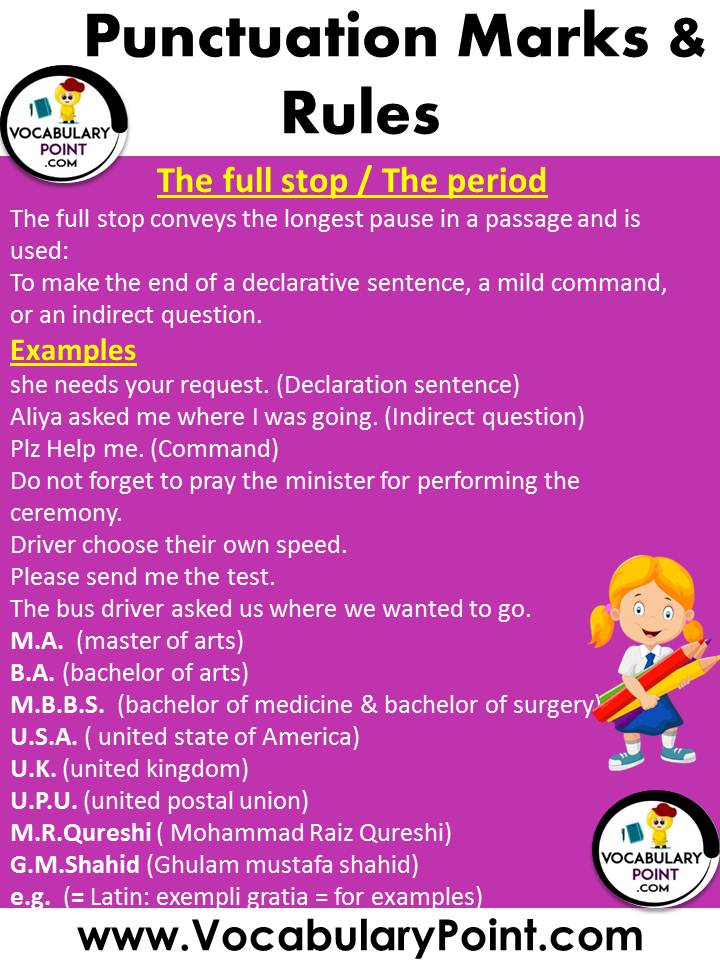





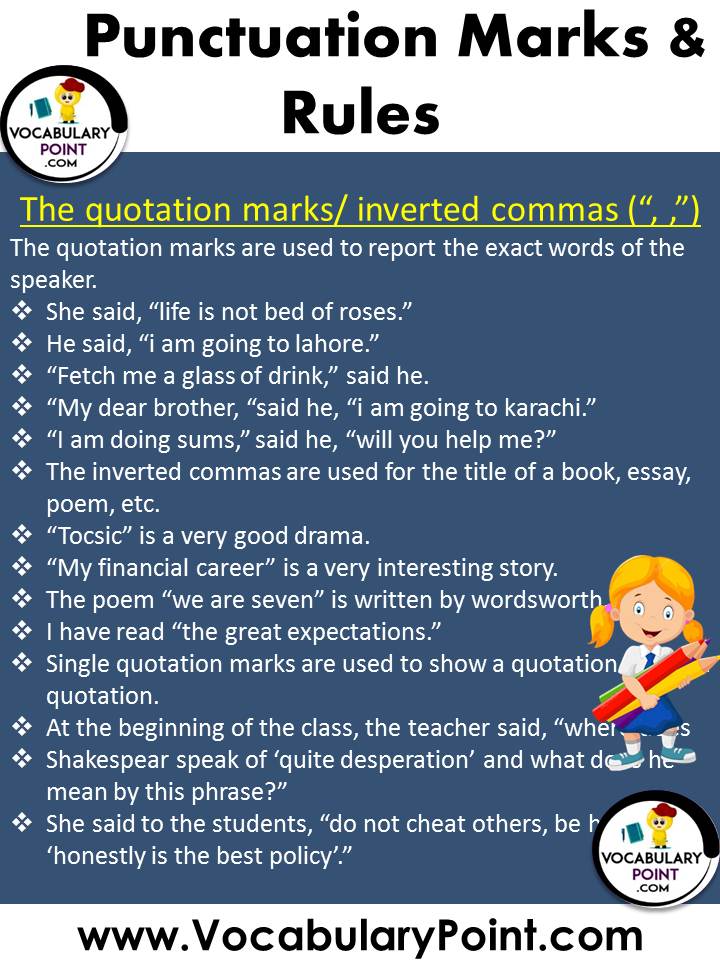

Punctuation Marks And Their Uses And Examples
- Period (.)
- Use: Indicates the end of a sentence or an abbreviation.
- Example: “She loves to read.”
- Comma (,)
- Use: Separates parts of a sentence, lists, or clauses.
- Example: “I bought apples, oranges, and bananas.”
- Exclamation Mark (!)
- Use: Shows strong emotion or emphasis.
- Example: “Watch out!”
- Question Mark (?)
- Use: Marks the end of a question.
- Example: “Are you coming to the party?”
- Colon (:)
- Use: Introduces lists, explanations, or quotations.
- Example: “She has three hobbies: reading, gardening, and painting.”
- Semicolon (;)
- Use: Connects closely related independent clauses or separates items in a complex list.
- Example: “She loves Paris; he prefers Rome.”
- Dash (—)
- Use: Indicates a break in thought, a range, or adds emphasis.
- Example: “He was the one who—unbelievably—forgot the tickets.”
- Hyphen (-)
- Use: Joins compound words or splits a word at the end of a line.
- Example: “A well-known artist”
- Apostrophe (’)
- Use: Indicates possession or forms contractions.
- Example: “It’s John’s book.”
- Quotation Marks (“ ”)
- Use: Encloses direct speech, quotes, or titles.
- Example: “She said, ‘I’m happy to be here.'”
- Parentheses ( ( ) )
- Use: Encloses additional information or asides.
- Example: “He finally answered (after taking five minutes to think).”
- Brackets [ ]
- Use: Encloses clarifications or corrections within quotations.
- Example: “He [the CEO] resigned yesterday.”
- Ellipsis (…)
- Use: Indicates an omission or a pause in dialogue.
- Example: “Well, I don’t know… maybe.”
- Slash (/)
- Use: Indicates alternatives, fractions, or separations.
- Example: “Please read the chapter on ethics/morality.”
- Asterisk (*)
- Use: Indicates a footnote or an emphasis on a word.
- Example: “This point is crucial*.”
- Ampersand (&)
- Use: Represents ‘and’, often used in business names.
- Example: “Johnson & Johnson”
- Pound/Hash (#)
- Use: Marks numbers or hashtags in social media.
- Example: “#MondayMotivation”
- Tilde (~)
- Use: Indicates approximation or is used for decorative purposes.
- Example: “~5 kilometers away”
- Angle Brackets (⟨ ⟩)
- Use: Encloses technical or specific content.
- Example: “<Enter your password>”
